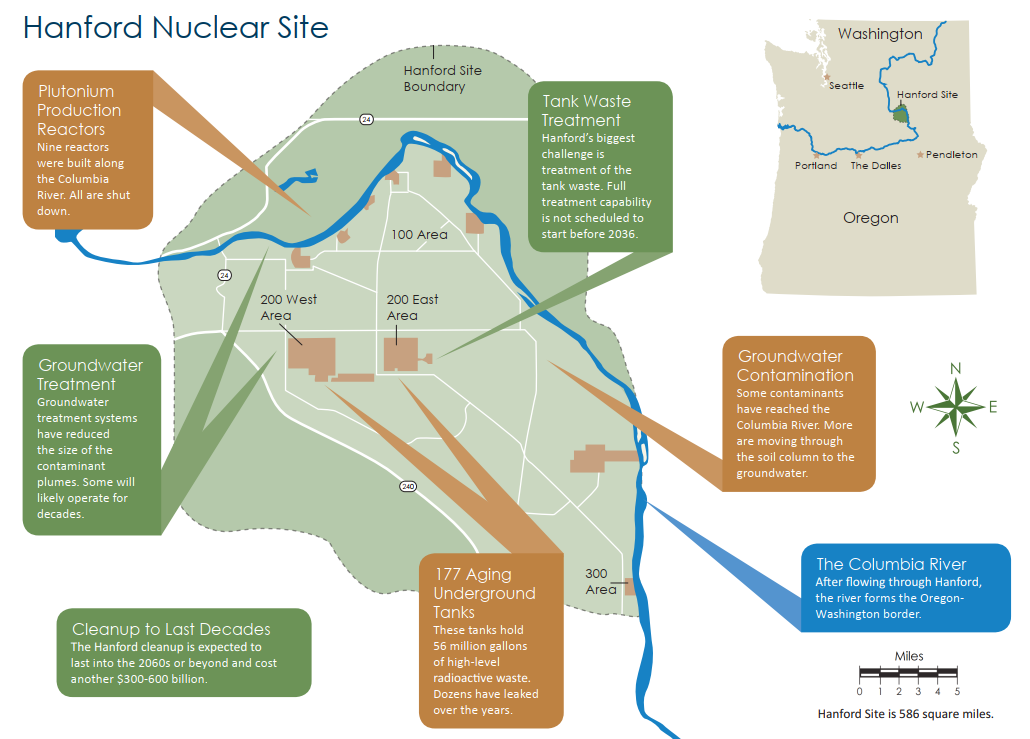For more than 40 years, the federal government produced plutonium for America's nuclear weapons program at the Hanford nuclear site in southeast Washington.
Hanford's plutonium production process created large amounts of radioactive and chemically hazardous waste. Since plutonium production ended in 1989, the focus at Hanford has shifted to waste cleanup.
 (click to enlarge)
(click to enlarge)
Oregon’s Role at Hanford
Oregon has a tremendous stake in ensuring the safe and timely cleanup of Hanford. Hanford sits on the Columbia River, just 35 miles from Oregon’s border. From Hanford, the Columbia flows through prime Oregon farmlands and fisheries. Radioactive and chemical contamination poses a potential long-term threat to these important resources. Accordingly, the Oregon Department of Energy’s (ODOE) primary role is to ensure cleanup decisions are protective of the river.
While Oregon has no regulatory authority at Hanford, the federal government recognizes ODOE as a critical, objective voice in technical reviews and policy discussions related to the cleanup.
ODOE also staffs the Oregon Hanford Cleanup Board, which provides input to the United States Department of Energy (U.S. DOE) and its regulators on the cleanup. The 20-member advisory Board includes 10 citizen members, six state legislators, and representatives from the Governor's Office, the Confederated Tribes of the Umatilla Indian Reservation, and two state agencies. ODOE and the Board keep important cleanup issues visible, hold the USDOE and its contractors accountable, ensure good public involvement and outreach, and convey that the cleanup is a regional issue and that Oregon has a stake in the outcome.
The Problem
More than 2,000 distinct waste sites have been identified at Hanford, ranging from small areas of surface contamination to hundreds of solid waste burial trenches. There are hundreds of contaminated facilities, including nine nuclear production reactors, laboratories, and large chemical reprocessing plants.
An estimated 444 billion gallons of contaminated liquid was dumped into the soil, causing extensive contamination of Hanford's groundwater. The most hazardous of the liquid waste was pumped to 177 underground storage tanks.
During Hanford's operating years, it was assumed that the disposal of most of the waste into the soil was permanent. However, the spread of contamination from the liquid waste disposal - and the need to remove solid waste near the Columbia River and elsewhere - necessitated the need to remove waste.
Hanford workers often deal with high levels of radioactivity or chemical contamination that require them to use remote-handled equipment or robotics. Sometimes the workers must be completely covered with protective suits and breathing equipment. In some cases the waste is unique to Hanford, so experts must develop new methods to clean up the waste products.
Cleanup is Progressing at Hanford
The U.S. DOE, which
owns and operates the Hanford site, has made significant progress on several
Oregon cleanup priorities. The extent of the contamination is so widespread
however, and some of the challenges so difficult, that the U.S. DOE expects cleanup to
continue for another 40 years or more. Work has focused in recent years along the Columbia River shoreline. The
cleanup of burial grounds, waste sites, and contaminated buildings along the
river corridor was mostly complete by 2015, with a few notable exceptions including two burial grounds, one reactor area, and high levels of
radioactivity beneath one building.
The U.S. DOE has
expanded groundwater treatment systems along the river and elsewhere on site.
These systems will continue to run for the next few decades. The U.S. DOE also stabilized
weapons-grade plutonium for long-term storage and removed it from the site.
Construction
continues on the Waste Treatment Plant, a massive collection of facilities to
immobilize Hanford’s 56 million gallons of high-level waste stored in 177 aging
underground storage tanks. At least 63
of the tanks have leaked an estimated one million gallons of highly radioactive
waste into the soil. The U.S. DOE discovered in late 2012 that the inner shell of one
of Hanford’s 28 double-shell tanks was also leaking. The tanks are beyond their
life expectancy and become less able to contain waste as they age.
Dealing with
the tank waste is the most complex and costly challenge at Hanford. The Waste
Treatment Plant, once constructed and operating, will permanently immobilize
the waste through a process called vitrification.
In this process, plant workers add glass-forming materials to the waste under
heat to form molten glass. The molten material will then be poured into
stainless steel containers, where the glass would cool and harden. The waste
will still be radioactive, but no longer mobile and able to easily spread into
and through the environment. The most
highly radioactive portion of the vitrified waste is intended to eventually be
taken from Hanford and disposed in a deep geologic repository. The less
radioactive portion of the vitrified waste will be buried at Hanford.
The Waste Treatment Plant was scheduled to begin
start-up operations in 2019 and reach full operations in 2022. However,
technical design issues remain to be resolved and will cause delays in the
schedule. It is now not scheduled to be fully operational until 2036. DOE is
currently pursuing a plan to bypass one troubled facility in favor of a more
simplified process to remove solids and certain radioactive materials and send
that waste feed directly to vitrification. DOE is
hopeful it could have this process in operation by late 2023